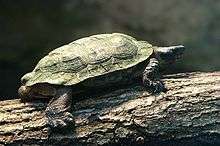List of reptiles of West Virginia









There are 39 species of reptiles whose ranges include at least parts of the state of West Virginia, USA. With 20 species of snakes, 13 turtle species, and 6 lizard species, the state's reptile diversity is high. However, many of these species are declining in population due to habitat destruction, water pollution, and the killing of reptiles out of ignorant fear.[1]
The taxa
The following letters indicate the likelihood of finding each animal in West Virginia:[2]
| C | Common | Can be commonly seen in suitable habitat within current range. |
| U | Uncommon | Seldom seen because habitat restricted and/or behavior secretive. |
| R | Rare | Not often present even in suitable habitat. |
Order Testudines (turtles)
Family Chelydridae (snapping turtles)
- Common snapping turtle (Chelydra s. serpentina) C
Family Emydidae (pond turtles)
- Spotted turtle (Clemmys guttata) R
- Wood turtle (Glyptemys insculpta) U
- Eastern box turtle (Terrapene c. carolina) C
- Northern map turtle (Graptemys geographica) U
- Ouachita map turtle (Graptemys o. ouachitensis) R
- Eastern painted turtle (Chrysemys p. picta) C
- Midland painted turtle (Chrysemys picta marginata) C
- Red-eared slider (Trachemys scripta elegans) C
- Eastern river cooter (Pseudemys c. concinna) U
- Northern red-bellied cooter (Pseudemys rubriventris) U
Family Kinosternidae (mud turtles and musk turtles)
- Common musk turtle (Sternotherus odoratus) C
Family Trionychidae (softshells)
- Northern spiny softshell turtle (Apalone s. spinifera) C
- Smooth softshell turtle (Apalone m. mutica) R
Order Squamata (scaled reptiles)
Family Phrynosomatidae (spiny lizards)
- Eastern fence lizard (Sceloporus undulatus) C
Family Teiidae (whiptails)
- Eastern six-lined racerunner (Aspidoscelis s. sexlineata) U
Family Scincidae (skinks)
- Little brown skink (Scincella lateralis) U
- Five-lined skink (Plestiodon fasciatus) C
- Broad-headed skink (Plestiodon laticeps) U
- Northern coal skink (Plestiodon a. anthracinus) U
Family Colubridae (colubrid snakes)
- Queen snake (Regina septemvittata) C
- Northern water snake (Nerodia s. sipedon) C
- Northern brown snake (Storeria d. dekayi) U
- Northern redbelly snake (Storeria o. occipitomaculata) C
- Eastern ribbon snake (Thamnophis s. sauritus) U
- Eastern garter snake (Thamnophis s. sirtalis) C
- Eastern earth snake (Virginia v. valeriae) U
- Mountain earth snake (Virginia pulchra) U
- Eastern hog-nosed snake (Heterodon platirhinos) U
- Eastern worm snake (Carphophis a. amoenus) C
- Northern ringneck snake (Diadophis punctatus edwardsii) C
- Northern black racer (Coluber c. constrictor) C
- Northern rough green snake (Opheodrys a. aestivus) U
- Smooth green snake (Opheodrys vernalis) C
- Corn snake (Pantherophis guttatus) R
- Eastern ratsnake (Pantherophis alleghaniensis) C
- Northern pine snake (Pituophis m. melanoleucus) R
- Eastern kingsnake (Lampropeltis g. getula) R
- Black kingsnake (Lampropeltis nigra) C
- Eastern milk snake (Lampropeltis t. triangulum) C
Family Viperidae (vipers)
- Northern copperhead (Agkistrodon contortrix mokasen) C
- Timber rattlesnake (Crotalus horridus) C
Threatened species
According to the International Union for Conservation of Nature (IUCN), 4 reptile species in West Virginia are threatened with extinction.
Spotted turtle
The spotted turtle is classified as endangered. This turtle lives in a variety of wetland habitats, including vernal pools, swamps, bogs, marshes, small streams, and moist meadows. Threats include the collection for the pet trade, road mortality, and invasive plant species in its wetland habitats. Conservation efforts include the protection of suitable habitat and the prohibition of collection for the pet trade.[3]
Wood turtle
The wood turtle is classified as endangered. It inhabits the forested edges of clear, hard-bottomed streams and rivers, and hibernates in deep, flowing water. Its primary threats include habitat fragmentation due to urban development, collection for the pet trade, and road mortality. In addition, overpopulated raccoons (Procyon lotor) consume a significant amount of this turtle's eggs and hatchlings. Conservation efforts include the prohibition of collection for the pet trade, protection of suitable habitat, and the building of fences along roadsides.[4]
Eastern box turtle
The eastern box turtle is classified as vulnerable. This turtle can be found in many different habitats, including forests and meadows. Threats include habitat fragmentation due to urban development, the overuse of pesticides, collection for the pet trade, and road mortality. Conservation efforts include the protection of suitable habitat, restriction of collection for the pet trade, and the installation of wildlife crossings to allow turtles to cross roads and highways safely.[5]
Northern red-bellied cooter
The northern red-bellied cooter is classified as near threatened. This turtle inhabits large, deep bodies of water with plenty of aquatic vegetation and suitable structures for basking. Juveniles prefer to stay in smaller and shallower water bodies until they reach adulthood. Threats include habitat degradation due to urban development, intentional killings by humans, the spread of the invasive common reed (Phragmites), the decline of the native wild rice (Zizania), sedimentation of river bottoms, pollution from chemical spills, and shell rot disease. Conservation efforts include the protection of suitable habitat and the restriction on collecting wild turtles for food or the pet trade.[6]
See also
- Lists of reptiles by region
- West Virginia State Wildlife Center, a small zoo featuring native West Virginia animals
- Fauna of West Virginia
- List of West Virginia wildlife management areas
References
- ↑ http://www.wvdnr.gov/Wildlife/RepAmph.shtm
- ↑ http://www.wvdnr.gov/Publications/PDFFiles/amphibian%20checklist2.pdf
- ↑ van Dijk, P.P. 2013. Clemmys guttata. The IUCN Red List of Threatened Species. Version 2015.2. <www.iucnredlist.org>. Downloaded on 31 July 2015.
- ↑ van Dijk, P.P. & Harding, J. 2013. Glyptemys insculpta. The IUCN Red List of Threatened Species. Version 2015.2. <www.iucnredlist.org>. Downloaded on 31 July 2015.
- ↑ van Dijk, P.P. 2013. Terrapene carolina. The IUCN Red List of Threatened Species. Version 2015.2. <www.iucnredlist.org>. Downloaded on 31 July 2015.
- ↑ van Dijk, P.P. 2013. Pseudemys rubriventris. The IUCN Red List of Threatened Species. Version 2015.2. <www.iucnredlist.org>. Downloaded on 31 July 2015.